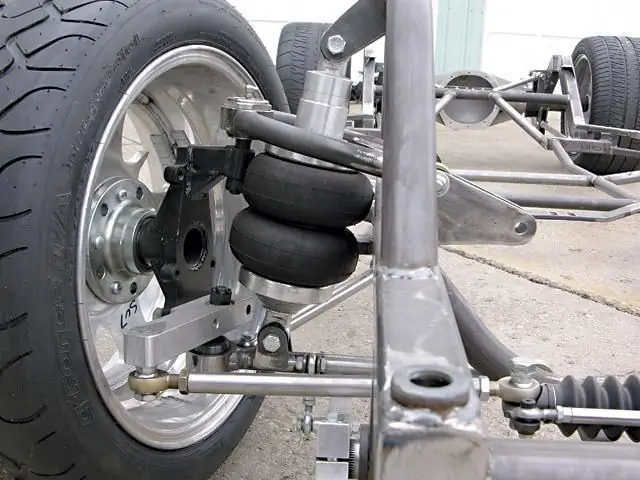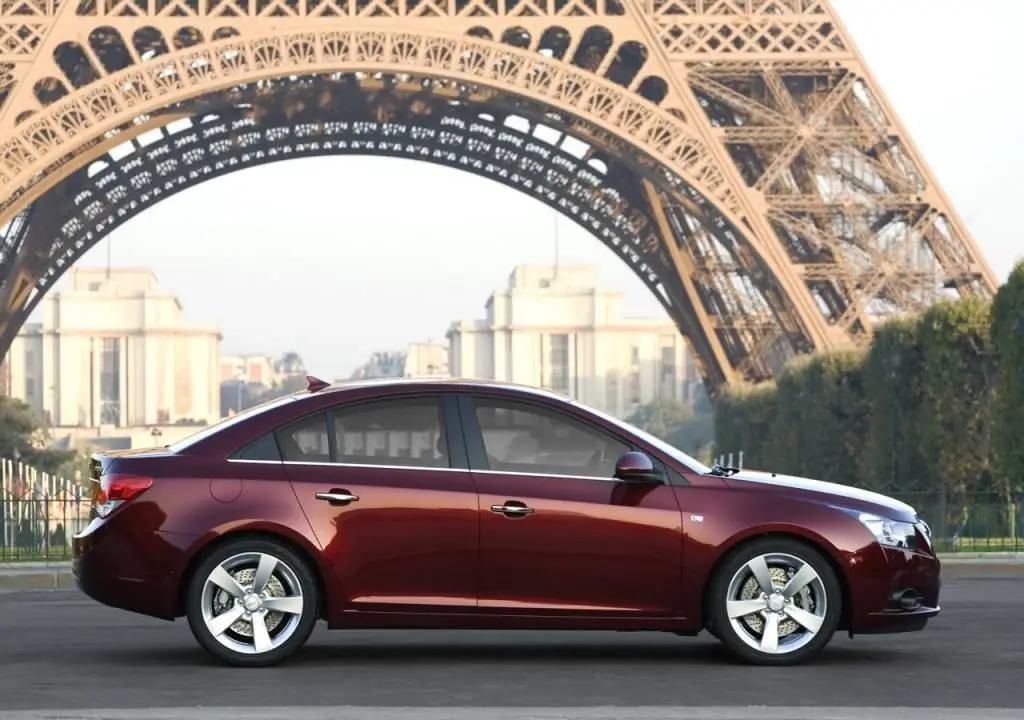2025 Author: Erin Ralphs | [email protected]. Last modified: 2025-01-22 21:14:09
Currently, there are cars with different types of drives. These are front, full and rear. When choosing a car, the future owner should know the features of each. Most professional drivers prefer to buy a rear-wheel drive car. What are its features? We will talk about this in our article.
Characteristic
A rear-wheel drive vehicle implies a classic layout and placement of units.

The engine and gearbox are located longitudinally here. This is the simplest scheme. Therefore, the first cars were precisely rear-wheel drive. But recently there has been a trend towards front-wheel drive. It is considered more technologically advanced. But manufacturers such as BMW, Mercedes and others still do not abandon the "outdated" layout.
Device
A rear-wheel drive car does not have a transverse engine. A simplified scheme is used here.

First comes the engine, then the gearbox, driveshaft and axle with differential. Unlike a front-wheel drive car, it has a more even weight distribution. Unlike "technological" analogues, here the mass is not concentrated at one point. Hence a more correct distribution of mass and load.
The main knots are:
- Drive shaft.
- Rear axle with differential.
Let's look at the features of each item.
Drive shaft
It is a cylindrical steel rod. Through the crosses, this shaft is attached to the gearbox. On the other hand, the mechanism is connected to the rear axle. The cardan shaft is located under the body. If it is a passenger car, a special tunnel is brought out to accommodate it.

This is necessary so that the metal rod does not deform against stones and asph alt. The driveline is very reliable. However, the main problems concern the crosses. They are constantly breaking down. And it doesn't matter what brand the rear-wheel drive car was produced. The exception is SHRUS connections. For the first time they were used on the Niva. However, the Ulyanovsk Kozlik (UAZ 469) still uses crosses as the main connection.
Rear Axle
It has a differential in its case. It is located in the middle of the bridge. It is this mechanism that receives torque from the driveline. Half shafts are built into the rear axle differential. They arefirmly attached to the wheels. When the driveshaft rotates, it drives the differential.

He, in turn, rotates the wheels through the axle shaft. Also note that transmission fluid is used inside the rear axle to lubricate the differential gears and axle shafts. In order for it not to leak out, seals are provided in the design. On some cars, the rear axle is also recessed into the body so that the mechanism is less damaged. However, because of this, the space in the cabin and trunk is significantly reduced. But why then are rear-wheel drive cars of the BMW, Infiniti and so on brands still being produced? There are reasons for this. Let's take a look at the benefits of this type of drive.
Pros
The first plus is the free space under the hood. It is much larger in rear-wheel drive cars due to the uniform arrangement of elements. On the front-wheel drive, all nodes are assembled precisely in the engine compartment. This makes vehicle maintenance difficult. The next plus is the correct weight distribution. Thanks to this, we get a uniform load on the front and rear axles. Also, this type of drive transmits less vibration to the steering wheel and the body itself. The car responds well to steering.

If desired, you can enter a controlled skid. There will be nothing on the rear axle of a rear-wheel drive car. If you release the gas, the car will level out again and continue moving. It is rear-wheel drive suitable for drifting. Leading loadis carried out on the rear axle, and the front one performs only the control function. You will not hear vibrations from the transmission and other components, as it happens on some front-wheel drive cars. The next plus is maneuverability. There are no CV joints on the front wheels in the design, and therefore the turning angle is much larger. This is very useful when driving in a traffic jam or while parking. The angle of inversion on such cars is 15 percent greater than on front-wheel drive. Also note the high maintainability. Service here is much cheaper. Not surprisingly, commercial vehicles are still equipped with this type of drive.
Dynamics of acceleration
We will pay special attention to this aspect. On such machines, more dynamic acceleration.

If you "go too far" with gas, then at the start you can get a skid of a rear-wheel drive car. At this time, the car body goes back. Based on the laws of physics, the load on the rear axle increases. As a result, the wheels get more grip. The machine does not grind, as it is on the front drive. And no matter what engine power - the result will be about the same. Therefore, only rear-wheel drive cars are used in drag racing.
Flaws
The design assumes the presence of many additional nodes. This is a cardan, bridge, differential, axle shafts. While to transmit torque on the front drive, it is enough to use a constant velocity joint. Therefore, the price of such cars is somewhat higher. The next is the presence of liquids. In differentialabout two liters of gear oil is used. It should be changed every 30 thousand kilometers. The CV joint is filled with grease for the entire period of operation. It is required to carefully monitor the condition of the seals. If the bridge is leaking, it is very bad.

When the lubrication level is low, the differential teeth wear more. And the cost of a new bridge, even for a domestic UAZ, is at least 40 thousand rubles. Another drawback is the presence of protrusions in the cabin for the driveshaft and rear axle.
About patency
In terms of snowy roads or mud, rear-wheel drive loses significantly. The wheels push the car from behind. As a result, he "digs" himself a snow trap. The car starts to burrow. Therefore, on cross-country vehicles, it is used (no, not front), but all-wheel drive. However, due to the presence of two bridges and a transfer case, the design becomes much more complicated. This entails expensive repairs of components and assemblies. But in terms of cross-country ability, he is the leader.
Which cars are rear wheel drive?
As we said earlier, now this arrangement is made only on expensive cars. These are German BMW and Mercedes, Jaguar, Infiniti, Maybach, as well as some Japanese Toyota and Nissan cars. Among domestic ones, these are Volga and classic VAZ models. And of course, all commercial vehicles. Budget cars with this type of drive are not currently being produced.
Conclusion
So, we found out the features of the rear-wheel drive. In spite ofthe popularity of the competing front, it still remains relevant. This is especially true for commercial vehicles. After all, here comes the frame structure. And there is simply no point in making protrusions under the bridge and cardan - the ground clearance of the truck allows you to use them without additional tunnels.
Recommended:
Twin scroll turbine: design description, principle of operation, pros and cons

Twin scroll turbines are available with double inlet and twin impeller. The principle of their operation is based on the separate supply of air to the turbine impellers, depending on the order of operation of the cylinders. This provides many advantages over single-scroll turbochargers, the main ones being better performance and responsiveness
Supra SCR-500: description, pros and cons of the DVR

DVRs have long entered the life of every car owner. They help to solve many problems, for example, in disputes with traffic inspectors or conflict situations in an accident. Often they allow you to avoid unpleasant consequences from the actions of scammers. The choice of devices is so wide that it is difficult to immediately decide on a purchase. One of the interesting specimens is the Supra SCR-500
MacPherson suspension: device, pros and cons

Suspension is one of the main mechanisms in the design of any vehicle. Thanks to it, the car is able to move on uneven sections of the road, reducing bumps and vibrations. Also, the suspension is the link between the wheels and the body. The system provides an elastic connection between these elements. Today there are several types of chassis. However, one of the most common is the MacPherson strut
Air suspension: principle of operation, device, pros and cons, owner reviews. Air suspension kit for car

The article is about air suspension. The device of such systems, types, principle of operation, pros and cons, reviews, etc. are considered
"Chevrolet Cruz": the pros and cons of the car, specifications, equipment, features and owner reviews

In Russia, Chevrolet Cruze hatchbacks and sedans were produced at the company's plant in St. Petersburg (Shushary). With a station wagon body, cars were produced at the Avtotor plant in Kaliningrad. Reviews about this car are somewhat contradictory, especially in the Russian automotive community. In this article, we will analyze the pros and cons of the Chevrolet Cruze

